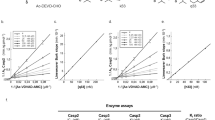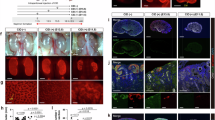Abstract
We report here that a number of commonly used small peptide caspase inhibitors consisting of a caspase recognition sequence linked to chloromethylketone, fluoromethylketone or aldehyde reactive group efficiently inhibit other cysteine proteases than caspases. The in vitro studies included cathepsins B, H, L, S, K, F, V, X and C, papain and legumain. Z-DEVD-cmk was shown to be the preferred irreversible inhibitor of most of the cathepsins in vitro, followed by Z-DEVD-fmk, Ac-YVAD-cmk, Z-YVAD-fmk and Z-VAD-fmk. Inactivation of legumain by all the inhibitors investigated was moderate, whereas cathepsins H and C were poorly inhibited or not inhibited at all. Inhibition by aldehydes was not very potent. All the three fluoromethylketones efficiently inhibited cathepsins in Jurkat and human embryonic kidney 293 cells at concentrations of 100 μM. Furthermore, they completely inhibited cathepsins B and X activity in tissue extracts at concentrations as low as 1 μM. These results suggest that data based on the use of these inhibitors should be taken with caution and that other proteases may be implicated in the processes previously ascribed solely to caspases.
Similar content being viewed by others
Log in or create a free account to read this content
Gain free access to this article, as well as selected content from this journal and more on nature.com
or
Abbreviations
- Ac:
-
acetyl
- AFC:
-
7-amido-4-trifluoromethylcoumarin
- AMC:
-
7-amido-4-methylcoumarin
- Bz:
-
benzoyl
- CA-074:
-
n-propyl-epoxysuccinyl-Ile-Pro
- Dnp:
-
2,4-dinitrophenyl
- E-64:
-
L-trans-epoxysuccinyl-Leu-amido-(4-guanidino) butane
- E-64d:
-
L-trans-epoxysuccinyl(OEt) -Leu-3-methylbutylamide
- β NA:
-
β -naphthylamide
- pNA:
-
p-nitroanilide
- Z:
-
benzyloxycarbonyl
References
Hengartner MO (2000) The biochemistry of apoptosis. Nature 407: 770–776
Lamkanfi M, Declercq W, Kalai M, Saelens X and Vandenabeele P (2002) Alice in caspase land. A phylogenetic analysis of caspases from worm to man. Cell Death Differ. 9: 358–361
Thornberry NA, Rano TA, Peterson EP, Rasper DM, Timkey T, Garcia-Calvo M, Houtzager VM, Nordstrom PA, Roy S, Vaillancourt JP, Chapman KT and Nicholson DW (1997) A combinatorial approach defines specificities of members of the caspase family and granzyme. B. J. Biol. Chem. 272: 17907–17911
Nicholson DW (1999) Caspase structure, proteolytic substrates, and function during apoptotic cell death. Cell Death Differ. 6: 1028–1042
Garcia-Calvo M, Peterson EP, Leiting B, Ruel R, Nicholson DW and Thornberry NA (1998) Inhibition of human caspases by peptide-based and macromolecular inhibitors. J. Biol. Chem. 273: 32608–32613
Nicholson DW (2000) From bench to clinic with apoptosis-based therapeutic agents. Nature 407: 810–816
Shaw E (1990) Cysteinyl proteinases and their selective inactivation. Adv. Enzymol. Relat. Areas Mol. Biol. 63: 271–347
Turk B, Turk D and Salvesen GS (2002) Regulating cysteine protease activity: essential role of protease inhibitors as guardians and regulators. Curr. Pharm. Des. 8: 1623–1637
Vancompernolle K, Van Herreweghe F, Pynaert G, Van de Craen M, De Vos K, Totty N, Sterling A, Fiers W, Vandenabeele P and Grooten J (1998) Atractyloside-induced release of cathepsin B, a protease with caspase-processing activity. FEBS Lett. 438: 150–158
Schotte P, Declercq W, Van Huffel S, Vandenabeele P and Beyaert R (1999) Non-specific effects of methyl ketone peptide inhibitors of caspases. FEBS Lett. 442: 117–121
Faubion WA, Guicciardi ME, Miyoshi H, Bronk SF, Roberts PJ, Svingen PA, Kaufmann SH and Gores GJ (1999) Toxic bile salts induce rodent hepatocyte apoptosis via direct activation of Fas. J. Clin. Invest. 103: 137–145
Gray J, Haran MM, Schneider K, Vesce S, Ray AM, Owen D, White IR, Cutler P and Davis JB (2001) Evidence that inhibition of cathepsin-B contributes to the neuroprotective properties of caspase inhibitor Tyr-Val-Ala-Asp-chloromethyl ketone. J. Biol. Chem. 276: 32750–32755
Foghsgaard L, Wissing D, Mauch D, Lademann U, Bastholm L, Boes M, Elling F, Leist M and Jäätelä M (2001) Cathepsin B acts as a dominant execution protease in tumor cell apoptosis induced by tumor necrosis factor. J. Cell. Biol. 153: 999–1009
Turk B, Turk V and Turk D (2000) Lysosomal cysteine proteases: more than scavengers. Biochim. Biophys. Acta 1477: 98–111
Leist M and Jäätelä M (2001) Triggering of apoptosis by cathepsins. Cell Death Differ. 8: 324–326
Turk B, Stoka V, Rozman-Pungerčar J, Cirman T, Droga-Mazovec G, Orešić K and Turk V (2002) Apoptotic pathways: involvement of lysosomal proteases. Biol. Chem. 383: 1035–1044
Chen J-M, Rawlings ND, Stevens RAE and Barrett AJ (1999) Identification of the active site of legumain links it to caspases, clostripain and gingipains in a new clan of cysteine endopeptidases. FEBS Lett. 441: 361–365
Barrett AJ, Kembhavi AA, Brown MA, Kirschke H, Knight CG, Tamai M and Hanada K (1982) L-trans-epoxysuccinyl-leucylamido(4-guanidino) butane (E-64) and its analogues as inhibitors of cysteine proteinases including cathepsins B, H and L. Biochem. J. 201: 189–198
Murata M, Miyashita S, Yokoo C, Tamai M, Hanada K, Hatayama K, Towatari T, Nikawa T and Katunuma N (1991) Novel epoxysuccinyl peptides. Selective inhibitors of cathepsin B, in vitro. FEBS Lett. 280: 307–310.
Tian WX and Tsou CL (1982) Determination of the rate constant of enzyme modification by measuring the substrate reaction in the presence of the modifier. Biochemistry 21: 1028–1032
Greco WR and Hakala MT (1979) Evaluation of methods for estimating the dissociation constant of tight binding enzyme inhibitors. J. Biol. Chem. 254: 12104–12109
Barrett AJ, Rawlings ND and Woessner JF (eds) (1998) Handbook of Proteolytic Enzymes (San Diego, CA: Academic Press)
Greenbaum D, Medzihradszky KF, Burlingame A and Bogyo M (2000) Epoxide electrophiles as activity-dependent cysteine protease profiling and discovery tools. Chem. Biol. 7: 569–581
Greenbaum D, Baruch A, Hayrapetian L, Darula Z, Burlingame A, Medzihradszky KF and Bogyo M (2002) Chemical approaches for functionally probing the proteome. Mol. Cell Proteomics 1: 60–68.
Greenbaum DC, Arnold WD, Lu F, Hayrapetian L, Baruch A, Krumrine J, Toba S, Chehade K, Brömme D, Kuntz ID and Bogyo M (2002) Small molecule affinity fingerprinting. A tool for enzyme family subclassification, target identification, and inhibitor design. Chem. Biol. 9: 1085–1094.
Thornberry NA, Peterson EP, Zhao JJ, Howard AD, Griffin PR and Chapman KT (1994) Inactivation of interleukin-1 beta converting enzyme by peptide (acyloxy) methyl ketones. Biochemistry 33: 3934–3940
Watt W, Koeplinger KA, Mildner AM, Heinrikson RL, Tomasselli AG and Watenpaugh KD (1999) The atomic-resolution structure of human caspase-8, a key activator of apoptosis. Structure Fold. Des. 7: 1135–1143
Kirschke H, Barrett AJ and Rawlings ND (1995) Proteinases 1: lysosomal cysteine proteinases. Protein Profile 2: 1581–1643
Hanada K, Tamai M, Yamagishi M, Ohmura S, Sawada J and Tanaka I (1978) Isolation and characterization of E-64, a new thiol protease inhibitor. Agric. Biol. Chem. 42: 523–528
Schaschke N, Assfalg-Machleidt I, Machleidt W, Turk D and Moroder L (1997) E-64 analogues as inhibitors of cathepsin B. On the role of the absolute configuration of the epoxysuccinyl group. Bioorg. Med. Chem. 9: 1789–1797
Parkes C, Kembhavi AA and Barrett AJ (1985) Calpain inhibition by peptide epoxides. Biochem. J. 230: 509–516
Sreedharan SK, Verma C, Caves LS, Brocklehurst SM, Gharbia SE, Shah HN and Brocklehurst K (1996) Demonstration that 1-trans-epoxysuccinyl-L-leucylamido-(4-guanidino) butane (E-64) is one of the most effective low M r inhibitors of trypsin-catalysed hydrolysis. Characterization by kinetic analysis and by energy minimization and molecular dynamics simulation of the E-64 –b-trypsin complex. Biochem. J. 316: 777–786
Bogyo M, Verhelst S, Bellingard-Dubouchaud V, Toba S and Greenbaum D (2000) Selective targeting of lysosomal cysteine proteases with radiolabeled electrophilic substrate analogs. Chem. Biol. 7: 27–38
Björklund HV, Johansson TR and Rinne A (1997) Rhabdovirus-induced apoptosis in a fish cell line is inhibited by a human endogenous acid cysteine proteinase inhibitor. J. Virol. 71: 5658–5662
Turk B, Turk V and Turk D (1997) Structural and functional aspects of papain-like cysteine proteinases and their protein inhibitors. Biol. Chem. 378: 141–150.
Pennacchio LA, Bouley DM, Higgins KM, Scott MP, Noebels JL and Myers R (1998) Progressive ataxia, myoclonic epilepsy and cerebellar apoptosis in cystatin B-deficient mice. Nat. Genet. 20: 251–258
Klemenčič I, Carmona AK, Cezari MH, Juliano MA, Juliano L, Gunčar G, Turk D, Križaj I, Turk V and Turk B (2000) Biochemical characterization of human cathepsin X revealed that the enzyme is an exopeptidase, acting as carboxymonopeptidase or carboxydipeptidase. Eur. J. Biochem. 267: 5404–5412
Blumberg S, Schechter I and Berger A (1970) The purification of papain by affinity chromatography. Eur. J. Biochem. 15: 97–102
Dolenc I, Turk B, Kos J and Turk V (1996) Interaction of human cathepsin C with chicken cystatin. FEBS Lett. 392: 277–280
Popović T, Brzin J, Kos J, Lenarčič B, Machleidt W, Ritonja A, Hanada K and Turk V (1988) A new purification procedure of human kidney cathepsin H, its properties and kinetics data. Biol. Chem. Hoppe-Seyler 369: 175–183
Dando PM, Fortunato M, Smith L, Knight G, McKendrick JE and Barrett AJ (1999) Pig kidney legumain: an asparaginyl endopeptidase with restricted specificity. Biochem. J. 339: 743–749
Kuhelj R, Dolinar M, Pungerćar J and Turk V (1995) The preparation of catalytically active human cathepsin B from its precursor expressed in Escherichia coli in the form of inclusion bodies. Eur. J. Biochem. 229: 533–539
Dolinar M, Barlič-Maganja D and Turk V (1995) Expression of full-length human procathepsin L cDNA in Escherichia coli and refolding of the expression product. Biol. Chem. Hoppe-Seyler 376: 385–388
Van de Craen M, Vandenabeele P, Declercq W, Van den Brande I, Van Loo G, Molemans F, Schotte P, Van Criekinge W, Beyaert R and Fiers W (1997) Characterization of seven murine caspase family members. FEBS Lett. 403: 61–69
Van de Craen M, Declercq W, Van den brande I, Fiers W and Vandenabeele P (1999) The proteolytic procaspase activation network: an in vitro analysis. Cell Death Differ. 6: 1117–1124
Wang B, Shi G-P, Yao PM, Li Z, Chapman HA and Brömme D (1998) Human cathepsin F. Molecular cloning, functional expression, tissue localization, and enzymatic characterization. J. Biol. Chem. 273: 32000–32008
Linnevers CJ, McGrath ME, Armstrong R, Mistry FR, Barnes M, Klaus JL, Palmer JT, Katz BA and Brömme D (1997) Expression of human cathepsin K in Pichia pastoris and preliminary crystallographic studies of an inhibitor complex. Protein Sci. 6: 919–921
Brömme D, Li Z, Barnes M and Mehler E (1999) Human cathepsin V functional expression, tissue distribution, electrostatic surface potential, enzymatic characterization and chromosomal localization. Biochemistry 38: 2377–2385
Turk B, Križaj I, Kralj B, Dolenc I, Popovič T, Bieth JG and Turk V (1993) Bovine stefin C, a new member of the stefin family. J. Biol. Chem. 286: 7323–7329
Stennicke HR and Salvesen GS (1997) Biochemical characteristics of caspases-3, -6, -7, and -8. J. Biol. Chem. 272: 25719–25723
Acknowledgements
This work was supported by the Ministry of School, Science and Sports of the Republic of Slovenia (BT, DT, VT), by the Interuniversitaire Attractiepolen V, the Fonds voor Wetenschappelijk Onderzoek Vlaanderen (Grant 3G.0006.01 to PV), the Bijzonder Onderzoeksfonds (PV), and an EC-RTD Grant QLRT-1999-00739 (PV), by Sandler Program in Basic Sciences (MB) and by the NIH Grant AR 46182 (DB).
Author information
Authors and Affiliations
Corresponding author
Additional information
Edited by G Salvesen
Rights and permissions
About this article
Cite this article
Rozman-Pungerčar, J., Kopitar-Jerala, N., Bogyo, M. et al. Inhibition of papain-like cysteine proteases and legumain by caspase-specific inhibitors: when reaction mechanism is more important than specificity. Cell Death Differ 10, 881–888 (2003). https://doi.org/10.1038/sj.cdd.4401247
Received:
Revised:
Accepted:
Published:
Issue date:
DOI: https://doi.org/10.1038/sj.cdd.4401247
Keywords
This article is cited by
-
Molecular basis of specificity and deamidation of eIF4A by Burkholderia Lethal Factor 1
Communications Biology (2022)
-
Bone morphogenetic protein receptor 2 inhibition destabilizes microtubules promoting the activation of lysosomes and cell death of lung cancer cells
Cell Communication and Signaling (2021)
-
Protein-coated corrole nanoparticles for the treatment of prostate cancer cells
Cell Death Discovery (2020)
-
Characterizing caspase-1 involvement during esophageal disease progression
Cancer Immunology, Immunotherapy (2020)
-
Caspases in retinal ganglion cell death and axon regeneration
Cell Death Discovery (2017)



